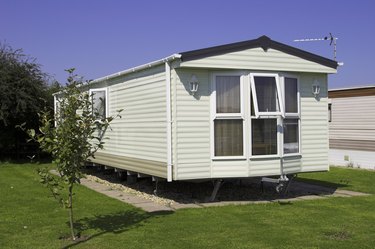
Mobile home skirting makes trailers look more attractive and protects the space under the home from the elements and curious critters. These five inexpensive mobile home skirting ideas each offer their own benefits. You should choose the right skirting for your mobile home based on your insulation needs, installation skills, budget, and aesthetic preferences.
1. Metal Skirting
Video of the Day
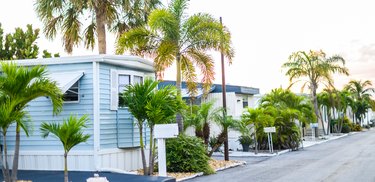
Durable and weatherproof, recycled steel and tin are affordable options for mobile home skirting. Easy to install, metal skirting attaches easily to a wooden 2-inch-by-4-inch frame with weatherproof nails or screws. In addition to new materials purchased at home centers, you may be able to find salvaged metals that work well for mobile home skirting. Many older sheds and barns used tin that was anodized— a form of paint bonding. When the paint begins to wear off, it reveals a patchwork that makes the tin appear textured, like an old brick wall—a look that can actually be somewhat attractive. Corrugated, galvanized roofing also works well for skirting. It's flat gray and may have a few rust spots, but it's durable and will withstand the test of time. Use it for an antique appearance.
Video of the Day
2. Concrete and Bricks
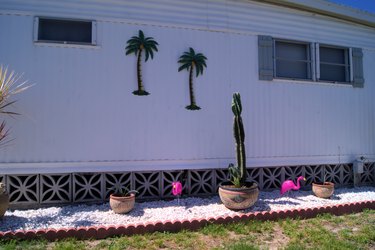
Concrete cinder blocks are durable, easy to work with, and they provide a certain amount of insulation. New cinder blocks can be expensive, but recycled blocks are available for a fraction of the cost. If some of the corners are broken, just place them facing the inside. Installing cinder-block skirting is a bit more labor intensive than other materials, but the benefit of longevity makes it worth the time and effort.
So-called "cinder blocks" come both in standard foundation building blocks and also in decorative wall blocks, sometimes known as "beauty block." Recycled bricks are another option for attractive skirting. They look fantastic, but, like cinder blocks, require a bit of effort to install. These materials also offer superior protection against the weather and unwanted animals. New brick costs 10 to 15 times what vinyl does, but it is unlikely to need replacing during the lifetime of the home.
Tip
A concrete pad is required if you want to install brick or cinder block skirting. The ground alone does not provide an adequate foundation for these skirting materials. Check with your local building inspector to learn what kind of foundation is required.
3. Wood
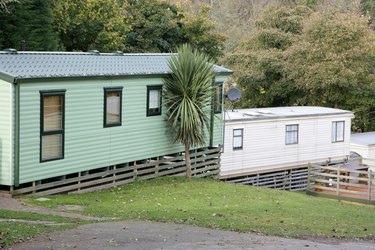
When properly sealed and treated against water and insects, wood makes for a versatile skirting material. Both hardiboard and OSB (oriented strand board) are extremely sturdy choices that will last for many years. When fitting treated boards together, caulk the ends for an extra seal against water.
Wood is highly customizable, allowing you to use a lattice or picket-fence pattern for a unique, homey look. If they are made from treated lumber or a naturally weather-resistant wood like cedar, old fence pickets can find new life as skirting rather being discarded.
4. Foam
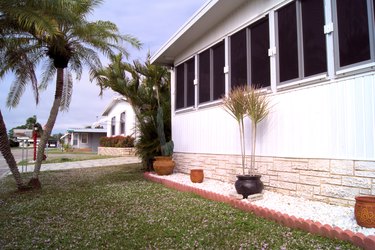
Most contemporary homes are shielded with rigid foam because of its insulating properties. This type of foam is available in large sheets, just like plywood. Use it to back up all other types of skirting for its insulating properties, or install it as stand-alone skirting.
Foam will not be as durable as other types of skirting, but it's affordable. If you keep the weed-eater away from it, foam will last for years. Rigid foam typically has one side that's bright white, which also looks great. Install double layers for even more stability.
If you find a little extra wiggle room in your budget, consider foams with a finished edge made to look like stone or brick.
5. Vinyl
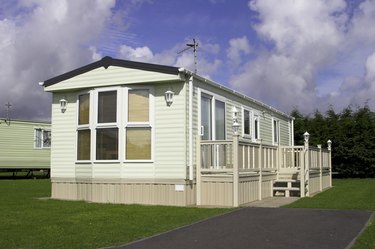
Vinyl skirting is somewhat less durable than other skirting options. It is, however, inexpensive, low maintenance, and will last at least for several year. Vinyl is available in a wide variety of colors to match your home and can be painted for an exact match if desired. To enhance vinyl skirting's longevity and insulation abilities, consider backing it with foam.
Things to Consider Before Purchasing Mobile Home Skirting
Do some preliminary planning before gathering materials for skirting. Here's what to consider before purchasing mobile home skirting:
- Measurements: It's always a good idea to add at least two inches to the height of the skirting — the extra two inches gives you something to work with if the ground is uneven. You can tuck the extra material under the aluminum fascia, if needed.
- Weather: Take some weather precautions before installing the skirting — no matter what kind of skirting you use or how well you insulate it, pipes will freeze without proper attention. Wrap them with insulation or, if you're in an area where it freezes hard each year, use electric pipe wrap that you can plug in when needed.
- Accessibility: Plan to install access doors and vents for airflow under the home to prevent problems with moisture and condensation.